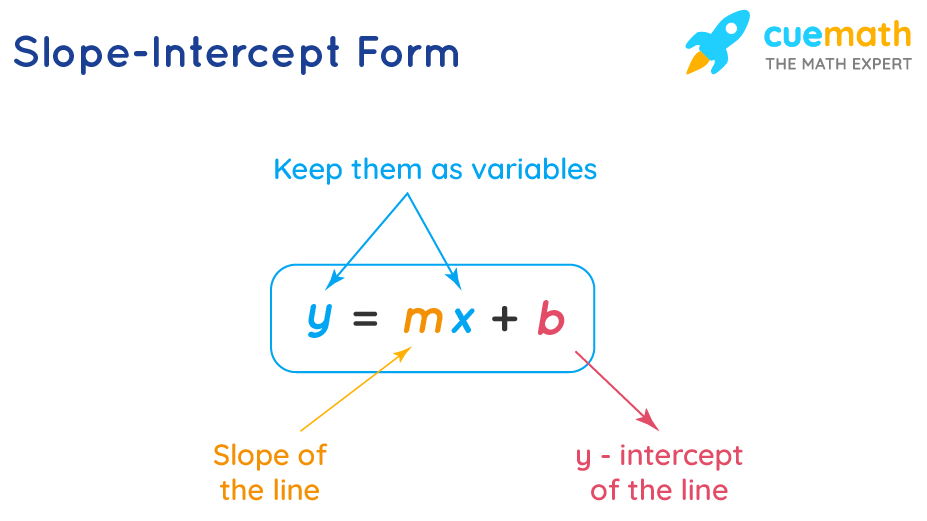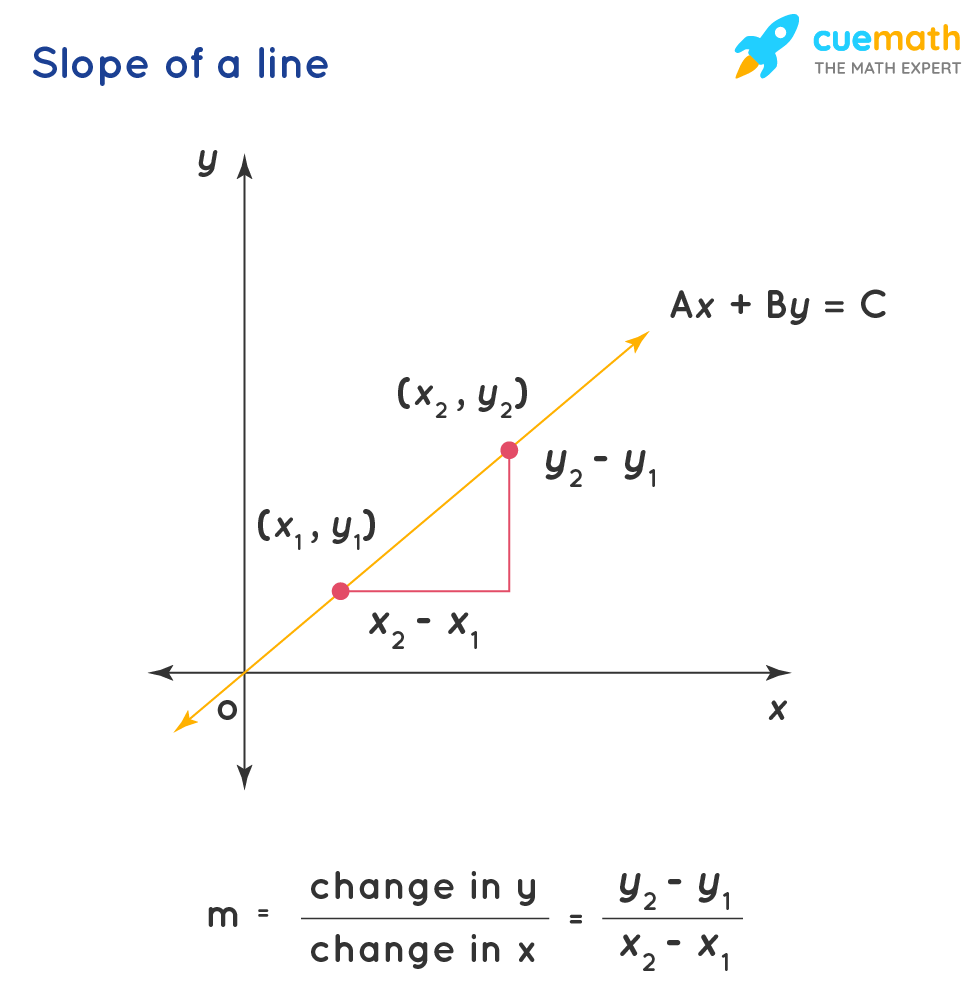How To Find B In Y Mx B
y=mx+b
y = mx + b is the slope intercept form of writing the equation of a straight line. In the equation 'y = mx + b', 'b' is the point, where the line intersects the 'y centrality' and 'g' denotes the slope of the line. The slope or slope of a line describes how steep a line is. It can have either a positive or a negative value. When a standard form of a linear equation is of the course Ax + By = C, where 'x' and 'y' and 'C' are variables and 'A', 'B' are constants, the slope-intercept form is the most preferred way of expressing a straight line due to its simplicity, equally it is very piece of cake to find the gradient and the 'y intercept' from the given equation.
| ane. | Meaning of y = mx + b |
| two. | How to Find y = mx + b? |
| 3. | Writing an Equation in the Slope Intercept Form |
| 4. | Solved Examples on y mx b |
| five. | Exercise Questions on y mx b |
| six. | FAQs on y mx b |
Pregnant of y = mx + b
y = mx + b is the gradient-intercept grade of a staight line. In the equation y = mx + b for a straight line, one thousand is called the slope of the line and b is the y-intercept of a line. y = mx+b, where
y ⇒ how far upwards or down is the line,
x ⇒ how far along is the line,
b ⇒ the value of y when ten = 0 and
one thousand ⇒ how steep the line is.
This is determined by k = (difference in y coordinates)/ (difference in x coordinates). Notation that difference in y coordinates is indicated every bit ascent or fall and divergence in ten coordinates is indicated as run.

How To Observe y = mx + b?
y = mx + b is the formula used to find the equation of a straight line, when nosotros know the slope(m) and the y-intercept (b) of the line. To determine 1000, we employ a formula based on the calculations. Let's derive this formula using the equation for the slope of a line. Allow us consider a line whose slope is 'm' and whose y-intercept is 'b'. Permit (ten,y) exist any other random point on the line whose coordinates are not known. We obtain the graph equally follows.

We know that the equation for the slope of a line in the gradient-intercept form is y = mx+b
Rewriting this, nosotros get m = (y-b) / x
Thus the formula to notice one thousand = change in y/ modify in x

Let us derive the formula to find the value of the slope if two points \((x_{1},y_{1})\) and \((x_{2},y_{ii})\) on the straight line are known. Then nosotros have \(y_{one} = mx_{1} + b\) and \(y_{2} = mx_{two} + b\)
Nosotros know that, slope = change in y/ change in x
Substituting the values of y1 and y2, we get \[\begin{marshal}\dfrac{y_{2}-y_{ane}}{x_{2}-x_{1}}&= \dfrac{(mx_{2}+b) - (mx_{1}+b)}{x_{two}-x_{i}}\\\\&=\dfrac{mx_{2}-mx_{1}}{x_{2}-x_{1}}\\\\&= \dfrac{m(x_{2}-x_{1})}{x_{2}-x_{i}}\\\\ &=yard\end{marshal}\]
Thus we find that the gradient (thou) is calculated as (modify in y)/ (change in x)
m = (departure in y coordinates)/ (difference in x coordinates)
To find the y-intercept or 'b', substitute the value of '10' as 0 in the equation of a straight line, which is of the form Ax + By + C = 0. Consider an equation of a straight line : 3x + 5y = 10. To notice the y-intercept, substitute the value of 'x' as 0 in the equation and solve for 'y'. On substituting 'x = 0' in the equation 3x + 5y =x, we get, three(0) + 5y = ten
⇒5y = 10 and thus y = x/5 ⇒ y = ii or 'b' = two.
Writing an Equation in The Slope Intercept Form
If the slope 'yard' and y-intercept 'b' are given, and then the equation of the straight line can be written in the form of 'y = mx +b'. For example, if the slope(thou) for a line is 2 and the y-intercept 'b' is -i, then the equation of the directly line is written as y = 2x - 1. The slope value can be positive or negative. As nosotros discussed in the earlier sections, in y = mx + b, 'chiliad' represents the slope of the equation. To detect the slope of a line, given its equation, nosotros have to rearrange its terms to the slope-intercept course y = mx + b. Here, 'thou' gives the slope and 'b' gives the y-intercept of the equation.
Let us consider the equation 2x + 3y = 6. We are required to find the gradient and the y-intercept from the equation which is of the form Ax + Past = C
We rewrite the standard form of the equation of the line to the slope-intercept form y = mx + b.
2x + 3y = 6
3y = 2x + 6
y = (-2/3) 10 + 2
Comparison the last equation with y = mx + b, nosotros obtain the slope of the equation is k = -2/3 and the y-intercept of the equation is, b = 2 or (0,2).
Of import Notes:
- The equation of the slope-intercept class of a line whose slope is 'm' and whose y-intercept is 'b' or (0,b) is y = mx + b.
- The equation of a horizontal line passing through (a,b) is of the form y = b.
- The equation of a vertical line passing through (a,b) is of the form x = a.
- m is calculated using the formula rise over run or (modify in y)/ (modify in x)
Topics Related to y = mx + b
Check out some interesting articles related to y = mx + b.
- Linear Equation Formula
- Equation of a Straight Line
- Linear Equations
- Linear Equations and Half Planes
- Betoken-slope formula
- Two Point Class
-
Example 1: Discover the equation of the line whose graph contains the points (ane,3) and (iii,7)
Solution:
The required equation of the line is y = mx + b
Using the formula for slope, chiliad = alter in y / change in x = \(\dfrac{y_{two}-y_{1}}{x_{2}-x_{i}}\)
= (seven-3)/ (3-1) = four/2 ⇒ m = 2
To find the y-intercept b, we consider any one of the coordinates.
Let united states utilize(ane,iii) and thou = 2 and substitute the values in the equation \(y_{ane} = mx_{1} + b\)
3 = 2(1) + b ⇒ b = 3 - ii = 1
Applying, chiliad =2 and b = 1 in the equation of the line(y = mx + b), nosotros get y = 2x + i Thus the equation of the directly line is y = 2x + one -
Example 2: Find the gradient-intercept form of a line with slope -2 and which passes through the betoken (-1.4).
Solution:
Nosotros know that the gradient-intercept course of a line is y = mx + b.
It is given that slope (thou) = -2 and the coordinates through which the line is passing through is (-1,4). Substituting the given values in the slope-intercept course equation we go, iv = (-two) (-1) + b.
4 = 2 + b b = four - 2 = two.
The slope intercept class of the line is y = - two x + 2.
go to slidego to slide

Take questions on basic mathematical concepts?
Become a problem-solving champ using logic, not rules. Learn the why backside math with our certified experts
Book a Free Trial Grade
FAQs on y mx b
What is y = mx + b?
y = mx + b is a representation of equation of a straight line. Information technology is called as the gradient intercept form. 'm' is referred to equally the slope of the line, and 'b' refers to the 'y -intercept' of the line.
How to Find the Slope of a Line?
For two coordinates, (xi,y1) and (x2, y2), the slope of a line is the ratio of difference between the difference between the y coordinates and the difference between 10 coordinates, also known as the rise over the run. The formula to detect the slope of a line is m = (y2-yi)/(x2-x1)
What is Slope-Intercept Form?
The equation of a straight line which is of the class y = mx + b, is chosen the gradient intercept form. Hither '1000' is the slope of the line and 'b' is the signal at which the line intercepts the y - centrality. An example for slope intercept form equation is y = 3x + 5
What is a Line With a Negative Slope?
A line for which the slope in negative is said to move from left to correct in a graph. The gradient of a line is plant by the ration of difference in y-coordinates to the deviation in ten-coordinates. If this value is negative for a line, then the line has a negative slope.
What Does the Slope of a Line Mean?
The management of a line is described by its gradient. The gradient can be positive or negative, based on its direction. A negative slope moves downward from left to right and a line with positive slope moves in the upward direction from right to left.
Source: https://www.cuemath.com/geometry/y-mx-b/
Posted by: hiersmorgilizeed.blogspot.com


0 Response to "How To Find B In Y Mx B"
Post a Comment